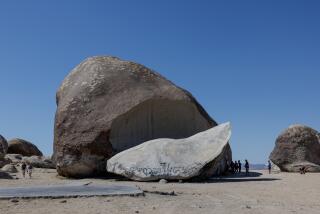Silent Stones Cast a Spell
- Share via
HEATH, Mass. — As cold and lonely as the winter sky, the standing stones atop Burnt Hill have snagged the imagination of fiction writers and generations of blueberry pickers.
But who erected them, and why, remains a mystery.
All told, 21 stones, some weighing 300 to 500 pounds, have been jammed into the bedrock on the 1,855-foot-high knoll in the state’s wild northwestern corner.
Five others have fallen. And interspersed among the monoliths are four glistening stacks of white quartz boulders.
For the last five years, about a half-dozen members of the New England Antiquities Research Assn., working weekends and winters, have been mapping and puzzling over the stones.
So far, the group has come up with more questions than answers, said Colgate Gilbert III, an amateur historian from Spofford, N.H., who heads the project.
They are not the first to wonder.
H.P. Lovecraft, who summered here in the 1920s, also fell under the stones’ spell.
According to local lore, the master of New England tales of the supernatural used the Heath stones to set the opening scene for his story “The Dunwitch Horror”: “Oldest of all are the great rings on rough hewn stone columns on the hilltops.”
Gilbert scoffs at such primeval hyperbole. But even without Lovecraft’s mythical “Old Ones,” there is plenty about the stones to puzzle over, he said.
“We didn’t anticipate the site would be anywhere near as complex as it is,” he said.
Initially, Gilbert thought they would quickly be able to establish that the stones were erected by a 19th-century farmer to mark the boundaries of his land or some similar purpose.
“We expected it to be very straightforward and very clear, with some tie to historical background,” he said.
But after five years of peering through surveyor’s transits and poring over old deeds and military diaries dating back to the French and Indian War, he has come to believe the stones were in place at least by 1750.
Instead of lining up with old boundary lines, they appear to point to the surrounding mountains, capturing such celestial events as the solstice sunrise and movements of the moon in the rugged teeth of New England’s high peaks.
If the hill was used as an observatory, the stones cannot be more than 1,000 years old, Gilbert said. Otherwise, because of the movement of the Earth, they would no longer be in sync with the celestial events, he said.
The stones can draw comparisons to the ancient monument Stonehenge in England, portions of which are believed to be about 5,000 years old. It is no longer in perfect alignment.
On a clear day, the top of the little knoll is a vantage point offering a stunning panorama of New England’s roof.
To the northwest are the white flanks of Haystack, Mt. Snow and the ski hills of Vermont.
To the west is the granite bulk of Mt. Greylock, the state’s highest peak.
Northeast in New Hampshire is the white crown of Mt. Monadnock, the region’s highest.
East are the towers of the University of Massachusetts in Amherst and beyond them the blue smudge of Mt. Wachusett, more than 50 miles away.
The old records hint that long before the settlers arrived, the hill was periodically burned by the Indian tribes that lived here to keep it clear for wild blueberries and to encourage deer to gather on the grasslands, Gilbert said.
Still, it is very much an open question if the tribes erected the stones.
The periodic burns have muddied the picture, but pollen-dating, which is one of the next avenues that Gilbert’s group plans to explore, may help provide clues as to how long ago the stones were set in place.
Fur traders and other adventurers were wandering through the area for a century, before the first colonial farmers settled here in the 1750s, Gilbert said.
And some archeologists were skeptical about any suggestion that the stones could be Indian work.
Dena Dincauze, a retired anthropology professor at the University of Massachusetts whose specialty is the native peoples of New England, said the tribes here did not build structures around their calendars. Dincauze, who has visited the site, noted that their calendars were based on the moon, not the sun.
They also built with wood, not stone, said Elizabeth Chilton, another anthropology professor at the university. Most such sites in New England have turned out to be a bit of Colonial whimsy, she said.
Still, the stones have an enduring fascination. For nearly 40 years they have been part of a privately owned blueberry farm, open to the public only during picking season.
“I started out thinking this would be a quick job and got hooked,” Gilbert said. “We’ve learned some things, but we still have a long way to go.”
More to Read
Sign up for Essential California
The most important California stories and recommendations in your inbox every morning.
You may occasionally receive promotional content from the Los Angeles Times.













